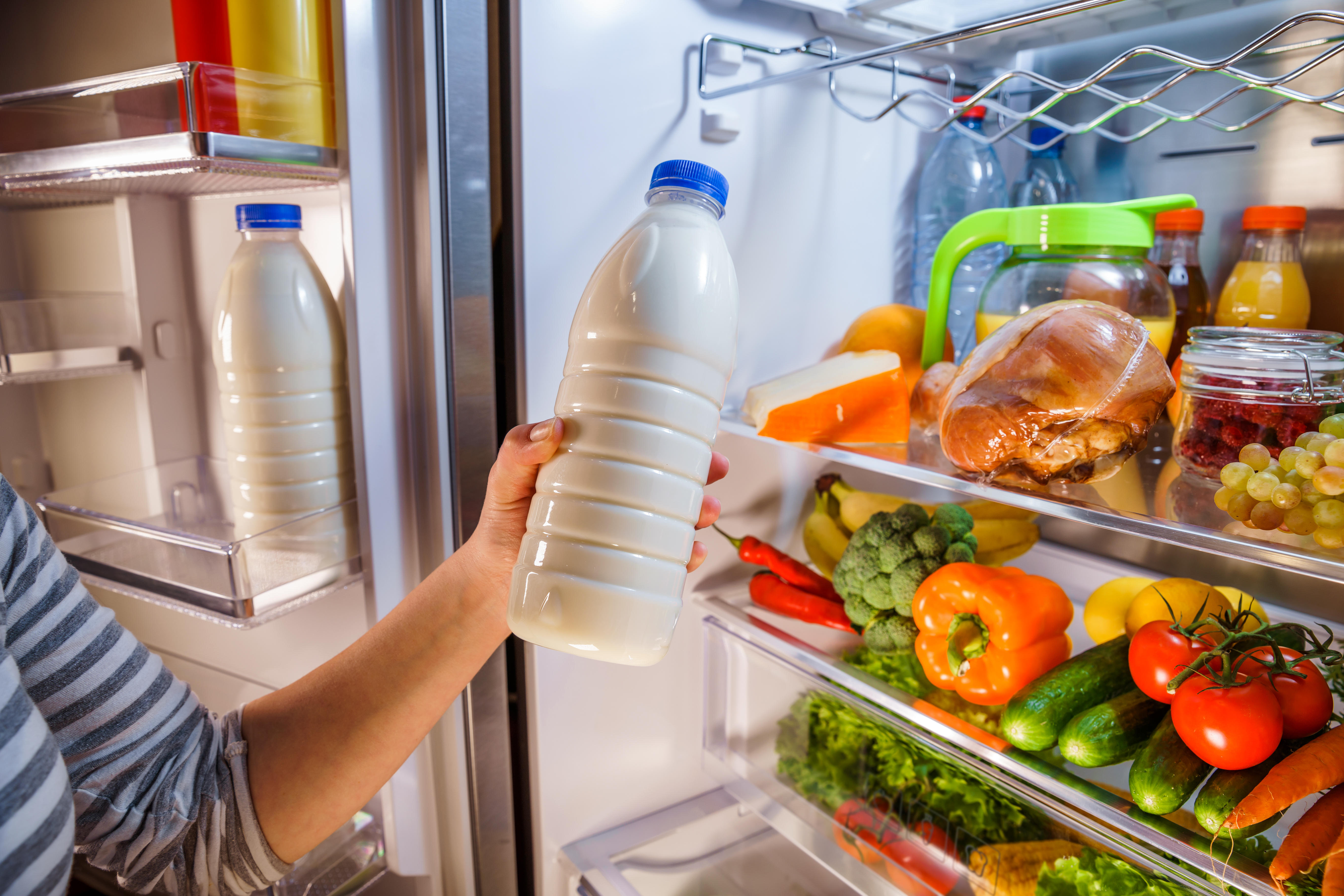Food and Tech: Solution to Preventing and Reducing Food Waste
By Alissa Link
What’s the scope of the problem?
Food waste represents a direct drain on resources at both the micro and macro levels, with producers utilizing labor, water and energy to produce food that will never be consumed and households spending money on food they never eat. For some estimates of how much food is wasted both in the U.S. and globally, see article one.
One quarter of the water used in agriculture is spent on wasted food. Food production also has significant environmental consequences including carbon dioxide and methane emissions, and food waste is the largest contributor by volume to landfills. While redirecting wasted food can help address food insecurity, preventing that food from being wasted in the first place has both environmental and financial benefits for food producers.
Where are the gaps in the current system?
Food waste occurs at many points throughout the food system, including overproduction on farms, spoilage during storage and transport, mismatches between supply and demand at retail outlets, and mismanagement of the household food supply. Waste from consumer-facing businesses (such as grocery stores and restaurants) and homes accounts for more than 80 percent of total food waste. Given the significant contribution to food loss and waste at each of these steps in the food chain, the problem is ripe for innovation.
In an analysis of the contributors to food waste, ReFED (a collaboration among stakeholders including businesses, nonprofits, foundations and government) identified opportunities for digital innovation. Solutions include tracking and analytics, improved inventory management, and consumer education campaigns.
This article describes strategies to prevent waste by cutting down on the amount of food produced, prepared and wrongly discarded.
Preventing and Reducing Waste in Commercial Kitchens
Commercial kitchens, including those in restaurants, school cafeterias and catering operations, are significant contributors to food waste. Predicting the amount of food that will be sold can be challenging, and companies may pride themselves on the freshness and quality of their food. While consumer-facing businesses account for 40 percent of total food waste by weight, commercial kitchens account for two-thirds of that.
One effective way of drawing attention to the inefficiencies of food service is to translate that waste into money lost by food businesses. By identifying the biggest waste areas and potential savings in each, food service businesses can save money and waste less food in the process.
Fully Integrated Waste Reduction Systems
LeanPath is a food-waste-prevention system that combines software with a smart scale and camera to track, monitor and calculate the impact of food waste in commercial kitchens. Staff use the scale to weigh and classify everything that is thrown out, from a piece of produce dropped on the floor to the food customers do not order or leave on their plates, and the software performs robust analyses to identify patterns. By placing the scale next to or above the kitchen’s main garbage container, this documentation step can be implemented without compromising or interrupting staff’s work pattern.
LeanPath App: Monitoring Food Waste and Tracking Its Financial Impact
What it does: LeanPath allows food service kitchens to monitor their food waste and see the financial impact it has on their business.
How it works: LeanPath’s automated software tracks food waste and provides suggestions for reducing waste and thus increasing profit.
Why it’s interesting: The app provides food waste solutions to increase profits for food-service businesses.
What can be learned from the technology: When food waste is expressed in terms of lost profits, businesses may be more likely to support measures to reduce it.
Created by: Andrew Shakman, Bill Leppo and Stephen Rogers
Website: https://www.leanpath.com/
Cost: Varies based on services.
Future of the service: The technology could be implemented in kitchens of all sizes around the world.
Case Study: Reducing Waste in a Hospital Kitchen
Gundersen Lutheran Health System in Wisconsin employed LeanPath’s ValuWaste tracking system and learned that it was generating 24 tons of food waste each year. After eight months of using LeanPath it was able to reduce food waste in its kitchen by 50 percent, saving $25,000. After several more months, Gundersen Lutheran estimated it was able to eliminate or repurpose close to 70 percent of its baseline waste amount and empty the kitchen’s trash bin once instead of three times a day.
The kitchen team commented that after the initial setup to customize the software to its kitchen’s data, the software does most of the work. The “30 seconds it takes employees to utilize the ValuWaste scale for food waste has become second nature and [has become a part of] standard operating procedures. The kitchen’s Executive Chef estimates he is spending roughly 60 minutes per week monitoring the reports and examining each staff member’s activity.”
By using these data, the health system identified specific areas where it could reduce waste. For example, a significant amount of spaghetti was being discarded because of the way it was wrapped in the refrigerator. The system then made changes, such as training kitchen staff in knife skills to cut produce more efficiently, altering the amount of soup heated during peak hours, and training workers in food storage techniques. The hospital’s kitchen also began donating its unused food to the local Salvation Army Food Pantry and Kitchen, providing more than 1,000 meals each month that otherwise would have been thrown out. The LeanPath system helped the hospital to conceptualize the large volume of food it was wasting and made it easier to take advantage of donation tax benefits.
Winnow is a platform similar to LeanPath that builds artificial intelligence tools to help chefs run more profitable and sustainable kitchens by cutting food waste in half. Winnow Vision is the latest tool from Winnow which allows kitchens to automatically track food waste. It uses computer vision (a form of artificial intelligence) to help chef’s easily pinpoint waste, cut costs and save time.
The system works by taking photos of wasted food as its thrown away and, using the images, the machine trains itself to recognise what has been thrown in the bin. Winnow’s test systems have reached and surpassed human levels of accuracy in identifying wasted foods.
This means that, over time, these systems will enable your kitchens to automatically register food waste without any human interaction. Food will be thrown in the bin and the data will be captured automatically. The more systems capturing data, the quicker the path to automation as the system needs time to get to predictive automation, dependant on the volume of data collected.
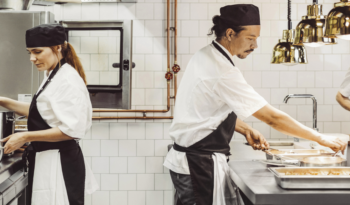
Photo Credit: Winnow
Winnow: Measuring Food Waste and Calculating Lost Profits
What it does: Winnow encourages businesses to prevent food waste by easily pinpointing waste, helping them to cut costs and save time to run more profitable and sustainable kitchens.
How it works: The Winnow systems weigh the amount of food as it is discarded in order to demonstrate just how much food is wasted. Winnow Vision uses cutting-edge AI technology to accurately identify waste patterns. This knowledge helps businesses reform practices to reduce waste and make significant cost savings.
Why it’s interesting: The system equates wasted food with wasted profits, with Winnow Vision using cutting-edge AI technology.
What can be learned from the technology: The groundbreaking technology of Winnow Vision has global application and is already delivering deep insight to over 100 kitchens from IKEA restaurants through to the The Armani Hotel.
Created by: Marc Zornes and Kevin Duffy
Website: https://www.winnowsolutions.
Cost: Varies based on services.
Future of the technology: Winnow’s technology increases staff awareness, and the company reports that its users reduce food waste by about 50 percent. This has been adopted by more than 1,000 sites globally, operating in 40 countries with offices in London, Dubai, Singapore, Shanghai and Iowa City. Kitchens that use Winnow tend to see a 40-70% reduction in food waste within 6-12 months, driving food cost savings between 2 and 8 percent.
Case study: IKEA and Winnow building the kitchen of the future
A Free Waste Reduction App for Smaller Restaurants
Wise Up On Waste is a free app provides tips on how to prevent food waste, and that lets chefs track waste in their kitchens and classify it as resulting from spoilage, preparation (e.g., trimmings or prepping more food than was cooked), or food left unneaten on consumers’ plates, while also calculating the potential cost savings of each. While this app requires manual data entry (versus a fully integrated smart scale), it is a more viable solution for smaller restaurants.
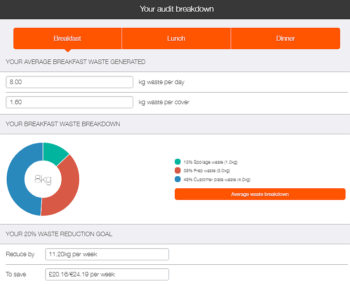
Photo Credit: Wise Up on Waste
Wise Up On Waste App: Auditing Food Waste in Professional Kitchens
What it does: Wise Up On Waste, targeted to professional kitchens, provides information about food-waste-prevention techniques and allows users to perform a food-waste audit.
How it works: Users can read about food-waste tips on the app, track their waste and learn how much money they could save by reducing waste.
Why it’s interesting: The app is essentially a database for professional kitchen workers.
What can be learned from the app: Food service workers may be more likely to consult recommendations about reducing food waste when they are easily accessible on an app.
Created by: Unilever Food Solutions
Website: https://www.unileverfoodsolutions.co.uk/menu-support/chef-inspiration/food-waste-reduction.html
Cost: Free
Future of the app: The app could be expanded to include more tips.
Preventing and Reducing Household Waste
Household waste is the single largest contributor to food waste, accounting for 43 percent of the 63 million tons wasted annually.
Consumer behaviors that can reduce food waste include:
- checking one’s refrigerator and pantry before shopping to avoid over-purchasing
- planning meals prior to food shopping
- estimating the amount of food needed and making a shopping list sticking to that shopping list while in the store.
Once the food is in the consumer’s home, strategies include:
- being smart about using leftovers
- tracking and remembering what food is on hand prioritizing use of food based on its projected shelf-life.
Teaching consumers how to properly store perishable products, understand product sell-by and use-by dates and make better use of their leftovers and ingredients on hand could play a significant role in reducing food waste.. A variety of apps, websites and new Internet of Things (IoT) devices employ these methods to help households reduce their food waste.
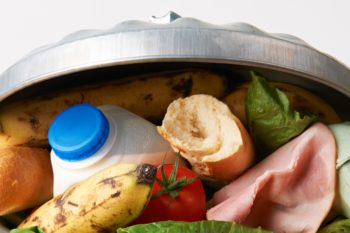
Food Date Labeling
Date labeling on foods causes much confusion among consumers and results in unnecessary household food waste. No regulations in the United States set guidelines for sell-by and use-by dates (except for infant formula). The Food Date Labeling Act of 2016 proposes to better align expiration dates on food labels with the food’s actual shelf life and safety.
What the Research Shows: Consumers Do Not Understand Date Labels
Consumers are often confused by “sell-by” versus “best before” or “use-by” dates, and up to 90 percent of Americans occasionally discard food that is still fresh. More than $29 billion worth of safe and edible food is discarded by consumers each year because of confusion over date labels. One study found that 22 percent of U.S. adults throw away milk according to the sell-by date, which is intended for retailers—not consumers—and provides a significant buffer for consumption.
This is problematic not only for households but also for grocery stores, most of which pull products off the shelves two or three days earlier than the sell-by date in order to meet customer expectations of “freshness.” In the United Kingdom, guidelines now advise retailers to remove the sell-by labels and use other [technology-based] systems for tracking stock and product shelf-life.
Understanding Shelf-Life and Best Practices for Storage
Several apps, such as the USDA’s FoodKeeper, Fridgely and Fridge Pal, and websites such as Still Tasty, seek to educate consumers about food shelf life by helping them track the status of purchased foods to improve decision-making about safety and disposal.
Fridgely alerts users when their food is nearing its expiration date. The app is equipped with a barcode scanner to allow users to easily enter their items and set expiration dates. The app can also send push notifications to remind individuals to use items that are expiring soon and can find recipes based on the ingredients users have on hand. Fridgely users may also share their food lists with others in their household.
Fridge Pal lets users create shopping lists, track expiration dates on the products they have at home, and find recipes that incorporate items they have in the refrigerator. Both apps allow users to organize their various food storage locations and customize how those are named (e.g., Garage Freezer versus Kitchen Freezer).
Testing of the Fridgely and Fridge Pal apps showed that Fridgely’s barcode scanner could correctly identify certain products that Fridge Pal’s missed. Fridge Pal also crashed unexpectedly, and there has not been an update to the application since early 2017. The recipe search features could also use improvement, as they do not consistently match the ingredient list to foods on hand.
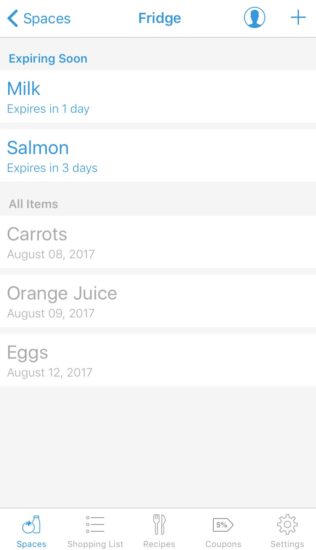
Photo Credit: Fridgely
Fridgely App: Alerting Users About Upcoming Food Expiration Dates
What it does: Fridgely helps users track the freshness of the food they have in the refrigerator so they can use it before it expires.
How it works: It sends reminders to indicate which foods will soon go bad and offers recipes to help use those foods.
Why it’s interesting: The app requires user input upfront but then provides automated information and reminders.
What can be learned from the app: Providing a system of organization can help users keep track of food inventory and reduce waste.
Created by: Justin Ehlert
Website: https://fridgelyapp.com/
Cost: Free
Future of the app: The app could improve its recipe features and allow for partial quantities to be entered so that users can optimize the ingredients they have on hand.
Still Tasty is a website that allows users to search or browse food and beverage products and learn how long they last in their various states. For example, a search for apples on the website produces separate and comprehensive information for apples that are frozen, canned (opened or unopened), dried and fresh (raw or cooked, whole or cut up). Each information page lists the shelf-life for various storage options (pantry, refrigerator or freezer) and provides tips for optimizing the shelf life (including how to prepare products for long-term storage in the freezer).
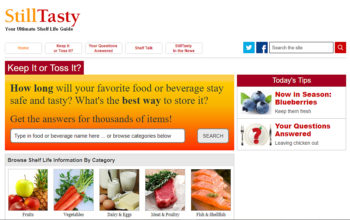
Photo Credit: Still Tasty
Meal Planning
A significant portion of household food waste could be prevented if consumers planned ahead before shopping to decide what meals will be cooked and when.
There are a variety of apps and websites that help consumers to manage meal planning and shopping more efficiently as well as to track and use the food they have on hand. Some of these were discussed in Part 1 (Health Tech & Food Insecurity), because strategies that reduce waste also create cost savings for the household.
The Love Food Hate Waste app helps consumers plan meals, shop for groceries, and cook and use leftovers, with the goal of reducing household food waste through the efficient use of ingredients on hand. The app allows users to enter their portion sizes (e.g., two adults and one child) and scales the recipes accordingly to minimize leftovers. Users can browse recipes by category (e.g., great for freezing or timesavers), albeit with a somewhat limited selection, and then add those ingredients (adjusting for the calculated portion size) to a shopping list. While this app has great potential, the user interface is not completely intuitive and would benefit from a wider selection of recipes and ingredients, and an option to enter additional ingredients already in one’s own kitchen.
Love Food Hate Waste App: Providing Recipes for Cooking What’s Already in the Kitchen
What it does: Love Food Hate Waste provides consumers with recipes based on leftover food already in their kitchen in an effort to reduce food waste.
How it works: The app lets users track food planning, shopping and cooking, and suggests recipes that reduce waste by making the most of leftovers.
Why it’s interesting: The app focuses on simple but effective strategies for reducing food waste in the home.
What can be learned from the app: When made accessible and interesting, food planning and using leftovers can be more appealing.
Created by: The Waste and Resources Action Programme (WRAP)
Website: https://www.lovefoodhatewaste.com
Cost: Free
Future of the app: The app could be expanded to include additional recipes.
The Love Your Leftovers app lets users search for recipes that can repurpose their leftovers once the food has been cooked.
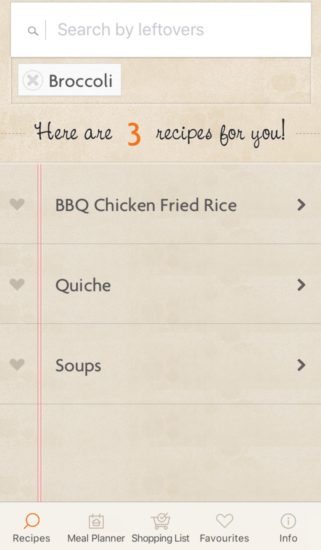
Photo Credit: Love Your Leftovers
Love Your Leftovers App: Helping Consumers Use Up Their Leftovers
What it does: Love Your Leftovers provides recipes that help people use the leftover food in their kitchen.
How it works: Users input ingredients they need to use up, and the app provides relevant recipes. The app also provides meal-planning and safe-storage tips.
Why it’s interesting: The app focuses on simple but effective strategies that will reduce food waste in individual homes.
What can be learned from the app: When made simple and interesting, using leftovers can be more appealing.
Created by: Cumberland County
Website: https://www.loveyourleftovers.nsw.gov.au/
Cost: Free
Future of the app: The app could be expanded to include additional recipes.
In general, all the apps that provide recipe suggestions, such as Love Food Hate Waste and Love Your Leftovers, would benefit from offering more options. For example, in Love Your Leftovers, searching for “quinoa” yields no results, and “green peppers” offers only three recipes. Additionally, apps with barcode scanners could incorporate more flexibility in how non-branded (e.g., fresh salmon) and branded ingredients are categorized.
Meal Kits
Handpick is an innovative food-waste prevention startup with multiple products. Their first product was an app that generates recipes based on the ingredients consumers have on hand. Users input combinations of ingredients, and the app suggests items that “pair well” with the ingredients already selected. The recipe app has a clean, attractive design, and a daily feed of recipes culled from popular food blogs and sites helps to keep their selections “fresh.” Handpick also offers a “meal kit” function, providing a set of ingredients and accompanying recipes that use all the ingredients in their entirety (i.e., rather than buying an entire bunch of basil and using it for only one recipe, the meal kit incorporates the basil into a number of recipes).
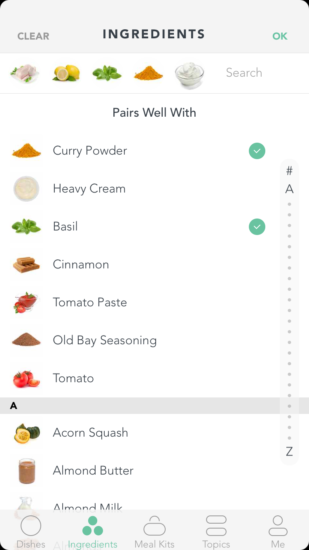
Photo Credit: Handpick
Despite its design-savvy interface and broad selection of recipes, Handpick does not offer comprehensive meal-planning features, such as the ability to keep a record of and track which ingredients one already has on hand; rather, it requires users to enter each of the ingredients they have every time they use the app to select a recipe.
Handpick has been working to expand their meal kit model by partnering with both brick-and-mortar and online grocery retailers to offer the set of ingredients in their meal kits as a ready-to-purchase package. In contrast to online meal kit companies such as Blue Apron and Plated (see Part 2, Feeding an Urban Population), Handpick uses grocery store products in the quantities in which they are normally sold and optimizes recipe and meal planning accordingly. The company also has the advantage of serving customers who prefer to purchase their groceries in person.
Smart Kitchens
More futuristic solutions include “smart” kitchen appliances such as the Family Hub refrigerator, which is equipped with cameras and wifi to help households automate the tracking of food products they have on hand.
Family Hub Refrigerator: A Smart Fridge That Reduces Duplicate Purchasing and Keeps Food Fresh
What it does: The refrigerator keeps food organized and fresh using a camera, wifi and enhanced cooling.
How it works: It has built-in cameras that take a picture of the inside of the refrigerator each time the doors close. These photos are accessible via a smartphone app so users can determine what they have and what they need to buy when they are already at the grocery store, thus eliminating duplicate purchasing. The fridge is also equipped with a triple cooling system that uses three evaporators to maintain a precise temperature that keeps food fresher longer.
Why it’s interesting: Samsung takes a basic refrigerator and enhances it significantly with built-in technology.
What can be learned from the technology: Automated technology may be more convenient and, therefore, more likely to be used than technology that requires manual input..
Created by: Samsung
Website: https://www.samsung.com/us/explore/family-hub-refrigerator/
Cost: Approximately $5,000-$6,000 depending on the model and retailer.
Future of the technology: Once it is made more accessible, this technology could help families at all socioeconomic levels.
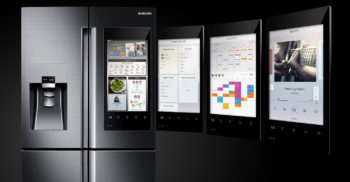
Photo Credit: Samsung
Preventing and Reducing Waste on Farms and in Storage
While the majority of food waste occurs at the retail and household levels, there are opportunities to reduce waste along all points in the supply chain.
Finding Markets for Ugly Produce
Fruits and vegetables are the largest category of global food waste. The USDA sets strict standards, as do many food retailers, on the aesthetic (e.g., color, shape, size) and functional (e.g., presence of stems, leaves, bruises, decay) qualities of the produce they will sell. In North America almost one-third of produce is rejected by grocery stores and supermarkets purely because of its appearance. Combining data from the United States, Canada, Australia and New Zealand, the Food and Agriculture Organization calculated that 52 percent of all fruits and vegetables are lost rather than consumed. In the States, more than 10 billion pounds of produce per year are either not harvested or never sold.
Imperfect Produce, Hungry Harvest, and Misfits Market all work directly with farmers and retailers to source “recovered” produce that would have otherwise been thrown away, and deliver it to customers at a 30 to 50 perent discount. Inspired by online CSA models (see Part 2, Feeding an Urban Population), these companies use web-based technology to run their operations, eliminating the need for a brick-and-mortar store, which helps them keep costs down and streamline their interactions with customers. Imperfect Produce is in the San Francisco Bay area (with plans to expand to Los Angeles), and Hungry Harvest operates in the Baltimore, Washington, D.C., and Philadelphia areas. Misfits Market currently delivers to all zip codes in Pennsylvania, New York, New Jersey, Connecticut, Delaware, Massachusetts, Vermont, New Hampshire, Rhode Island, Maine, and Ohio
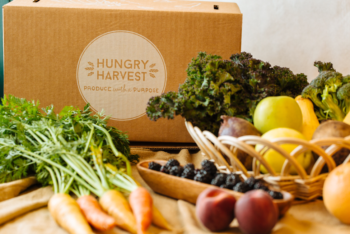
Photo Credit: Hungry Harvest
As a prime example of social entrepreneurship, Hungry Harvest uses their profit from each produce box to subsidize or donate one to three pounds of fresh produce to public schools located in food deserts. As of early 2017, the company had donated more than 400,000 pounds of fresh produce.
Cerplus was an online marketplace for surplus and “ugly” produce that has been temporarily discontinued (effective September 30, 2016) while they work on a new business model that they believe will have a much bigger impact on reducing waste. The company describes their previous model as “harvest-to-order” and believes their new “grow-to-order” platform will better maximize efficiencies while reducing waste. Growing food to order ties into many of the themes discussed in Part 2 (Feeding an Urban Population), such as farmers using data—or, in this case, proactive “demand” through an online ordering platform—to grow the right things in the right amounts, thus helping to prevent rather than repurpose waste.
Using Innovative Sensor Devices
Microchips that monitor storage conditions can help prevent food loss during post-harvest handling and storage. RFMOD, an engineering company in the United Kingdom, is developing ann Internet of Things–style “smart bean” that will monitor humidity, temperature and carbon dioxide levels. By placing several sensors throughout the silo or storage container, a three-dimensional wireless network can provide valuable data on potential spoilage or insect infestation.
Infratab is a Radio Frequency Identification (RFID) label that records freshness over the life-cycle of a product and can be used by the producer, transporter, retailer and consumer. For example, if a fruit is stored in conditions that exceed temperature limits, the label will send an alert that the product is likely to spoil faster than normally expected. At the household level, these sorts of technologies and tracking systems can ensure that families are using their purchased food in a timely and effective manner.
A young industrial designer from the United Kingdom has created a gelatin-filled “bump mark” (called the Mimica Touch), which is a food label that decays over time from a solid to a liquid and could be used for protein-based foods or drinks such as milk, meat and cheese if and when it reaches the marketplace. Because the gelatin is also a protein, it decays at the same rate as these products, producing bumps that can be felt on the label, thus alerting consumers not to purchase the food and retailers to pull products from their shelves.
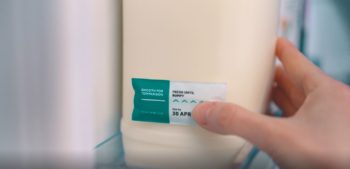
The Mimica Touch: A Tactile Technology to Determine a Food’s Freshness
What it does: The Mimica Touch indicates the freshness of a food item.
How it works: The technology uses gelatin to mimic the decay process of food and is placed on a food’s packaging. As the gelatin breaks down, bumps underneath are revealed. The consumer runs a finger over the label to determine the food’s freshness. When the label feels smooth, the food is fresh; if bumpy, the food should be discarded.
Why it’s interesting: The Mimica Touch reduces food waste by providing an accurate measure of it freshness so that consumers do not have to rely on an expiration date.
What can be learned from the technology: Consumers can benefit from technological indicators of freshness instead of arbitrary date labels.
Created by: Solveiga Pakstaite
Website: https://www.mimicalab.com/
Cost: Not yet for sale.
Future of the technology: The product is not yet on the market.
Looking Forward: Tech Opportunities to Prevent Food Waste
Commercial kitchens can both benefit financially and generate positive publicity by reducing food waste. The data from commercial food waste tracking systems help staff with decision-making and encourage creativity in using up leftover ingredients.
- The University of California San Francisco hospital system uses LeanPath in its kitchens and reported close to $60,000 in savings over 2 years, reducing their waste by 35 percent.
- ReFED estimates the business profit potential of waste-tracking and analytics platforms at $1 billion, with a potential for diverting 571,000 tons of food waste per year.
Some e-commercial kitchen products, like Winnow, could eventually be scaled down and used at the household and consumer level to allow individuals to better track and analyze the nature of their food waste and use that information to change their behavior. Consumers are generally quite cost-sensitive, and translating the food they throw out into dollar values could be a powerful motivator for behavior change. ReFED estimates that
- Consumer education campaigns could divert 584,000 tons of food waste, with an economic value of $2.65 billion.
- Standardizing date labeling could divert 398,000 tons of food waste, with an economic value of $1.8 billion.
While neither consumer education campaigns nor standardizing date labeling are solutions entirely driven by technological innovations, many of the apps and new labeling technologies described herein would contribute to those initiatives. However, apps such as Fridgely require significant upfront work to catalogue one’s entire pantry, refrigerator and freezer and provide value only if they are used consistently. Although, one might argue that using this type of app for only a short period of time might change the user’s awareness of products’ shelf-lives and their own planning strategies, thereby sustaining its impact over time.
Conclusion
Innovations become sticky only when they solve real problems for end-users. For example, the commercial kitchen food-waste tracking systems must be integrated into the workflow so that it becomes routine for staff to log discarded items. Features that automate as much of the process as possible, such as automatically filling out grocery lists based on selected recipes and scheduling those meals over a week’s time, get several “jobs” done for the user. Additionally, better integration among these types of software with online grocers and wholesalers could save households and commercial kitchens hours of work every week.
A 20 percent reduction in food waste over the course of a decade could divert 13 million tons from landfills and on-farm losses and equate to a net societal economic value of $100 billion. Reducing and preventing food waste translates to significant resource savings throughout the food system and has been an area of rapid innovation. As food-waste-prevention startups grow and scale, they could potentially have a significant impact on reducing food insecurity and the environmental burden of the food system.

